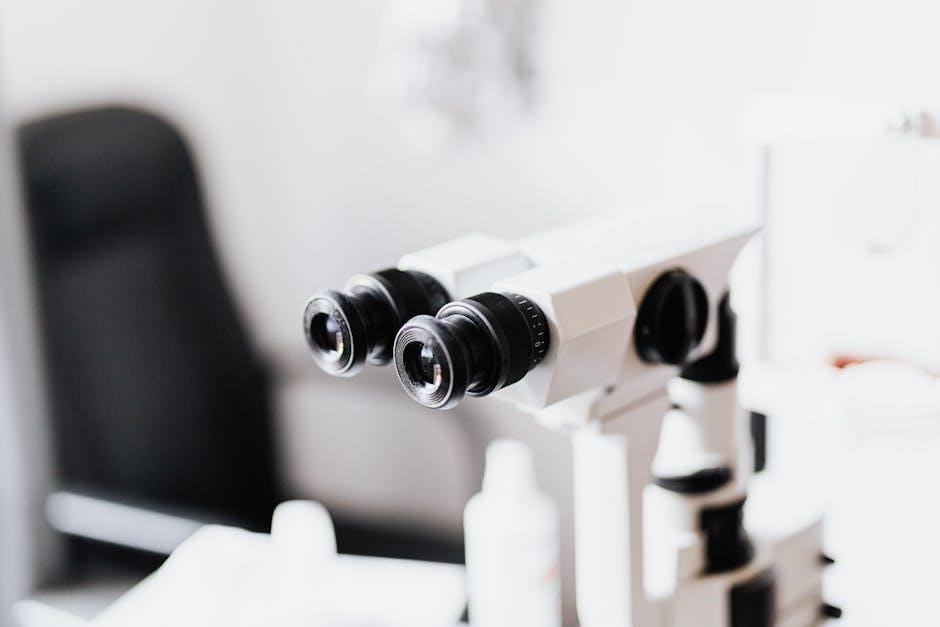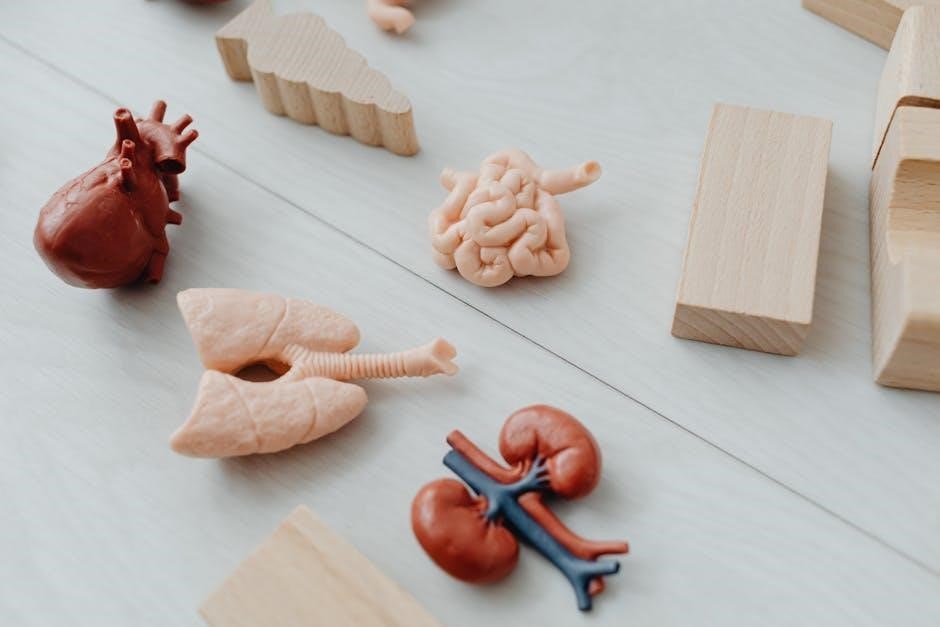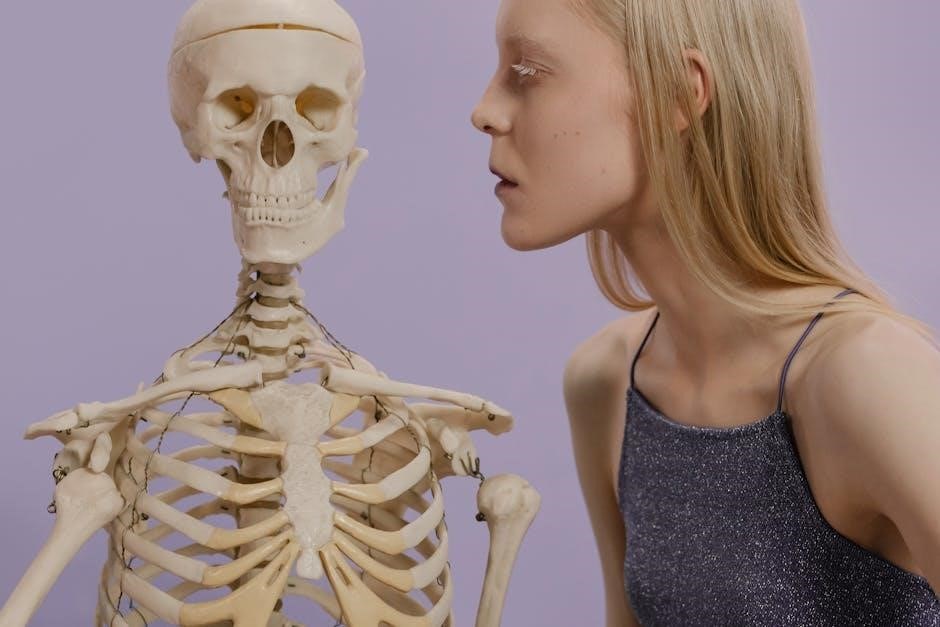This study guide provides a structured overview of key biological concepts. It will help you prepare for your biology final exam. Review each section carefully, focusing on understanding examples. Topics range from molecular biology to ecosystems. Success depends on understanding, not memorization! Good luck.
Key Biological Molecules
Understanding the fundamental biological molecules is crucial for excelling in biology. These molecules, primarily composed of carbon, hydrogen, nitrogen, and oxygen, form the building blocks of life. Focus on the four major classes: carbohydrates, lipids, proteins, and nucleic acids.
Carbohydrates, including monosaccharides, provide energy. Lipids, such as fats and oils, are vital for energy storage and cell structure. Proteins, composed of amino acids, perform diverse functions, from catalyzing reactions to transporting molecules.
Nucleic acids, DNA and RNA, carry genetic information. Pay close attention to the monomers that comprise each macromolecule. For example, amino acids are the monomers of proteins.
Understand how these molecules interact and their roles within cells and organisms. Remember, organic chemistry focuses on carbon compounds; Carbon’s ability to form four bonds enables the creation of diverse and complex molecules.
Isomers, with the same atoms but different structures, exhibit varying properties. Hydrocarbons consist solely of carbon and hydrogen. Mastering these concepts is vital for success on your biology final exam. Don’t underestimate their importance!
Cell Structure and Function
Cells are the fundamental units of life, carrying out all essential functions. Understanding cell structure and function is paramount in biology. Distinguish between prokaryotic and eukaryotic cells. Prokaryotic cells lack a nucleus, while eukaryotic cells possess a membrane-bound nucleus and organelles.
Key organelles include the nucleus (containing DNA), mitochondria (powerhouse of the cell), ribosomes (protein synthesis), endoplasmic reticulum (protein and lipid synthesis), Golgi apparatus (protein processing and packaging), lysosomes (waste disposal), and vacuoles (storage).
The cell membrane, composed of a phospholipid bilayer, regulates the passage of substances in and out of the cell. Understand the processes of diffusion, osmosis, and active transport.
Cellular respiration, occurring in the mitochondria, converts glucose into ATP, the cell’s energy currency. Photosynthesis, in plant cells, converts light energy into chemical energy.
Cellular reproduction, including mitosis and meiosis, ensures the continuation of life. Remember that cells are the smallest units capable of carrying out life functions. A strong grasp of these concepts is essential for your biology final exam and future studies in biology.
Photosynthesis Overview
Photosynthesis is the process by which plants and other organisms convert light energy into chemical energy in the form of glucose. This process is crucial for life on Earth, as it provides the primary source of energy for most ecosystems and produces oxygen as a byproduct.
Photosynthesis occurs in two main stages: the light-dependent reactions and the light-independent reactions (Calvin cycle). The light-dependent reactions take place in the thylakoid membranes of chloroplasts, where light energy is absorbed by chlorophyll and other pigments.

This energy is then used to split water molecules, releasing oxygen, protons, and electrons. The electrons are passed along an electron transport chain (ETC), generating ATP and NADPH, which are energy-carrying molecules.
The light-independent reactions, or Calvin cycle, occur in the stroma of the chloroplasts. In this cycle, carbon dioxide is fixed and converted into glucose using the ATP and NADPH produced during the light-dependent reactions.
Understanding the inputs (carbon dioxide, water, light energy) and outputs (glucose, oxygen) of photosynthesis is essential. Remember, the first ETC of photosynthesis forms NADPH, and the second ETC forms ATP, both crucial for the Calvin cycle.
Mitosis and Meiosis
Mitosis and meiosis are fundamental processes of cell division, each serving distinct purposes. Mitosis is the process of cell division that results in two identical daughter cells, each with the same number of chromosomes as the parent cell. This is essential for growth, repair, and asexual reproduction.
The stages of mitosis include prophase, metaphase, anaphase, and telophase. During prophase, the chromosomes condense and become visible. In metaphase, the chromosomes align at the metaphase plate. Anaphase involves the separation of sister chromatids, which are pulled to opposite poles of the cell. Finally, telophase sees the formation of two new nuclei, followed by cytokinesis, the division of the cytoplasm.
Meiosis, on the other hand, is a type of cell division that results in four genetically distinct daughter cells, each with half the number of chromosomes as the parent cell. This process is crucial for sexual reproduction, as it produces gametes (sperm and egg cells).
Meiosis involves two rounds of cell division: meiosis I and meiosis II. Meiosis I separates homologous chromosomes, while meiosis II separates sister chromatids, similar to mitosis. Crossing over occurs during prophase I, leading to genetic variation.
Understanding the key differences between mitosis and meiosis is crucial. Mitosis results in identical cells for growth and repair, while meiosis produces genetically diverse gametes for sexual reproduction. Be able to draw and explain the phases of both processes.

Evolution and Natural Selection (Darwin’s Steps)
Evolution, driven by natural selection, explains the diversity of life on Earth. Charles Darwin’s theory revolutionized biology. His work, particularly “On the Origin of Species,” outlined the principles of natural selection, which is a cornerstone of evolutionary biology. Darwin’s steps provide a framework for understanding this process.

The first step is variation: Individuals within a population exhibit differences. These variations arise from genetic mutations and sexual reproduction, resulting in diverse traits.
The second step is inheritance: Traits are passed down from parents to offspring. Heredity ensures that advantageous traits can be inherited by subsequent generations.
The third step is overproduction: Populations tend to produce more offspring than the environment can support. This leads to competition for limited resources;
The fourth step is differential survival and reproduction: Individuals with advantageous traits are more likely to survive and reproduce, passing on their genes to the next generation. This is natural selection in action, where the “fittest” individuals contribute more to the gene pool.
The fifth step is adaptation: Over time, the population evolves as the frequency of advantageous traits increases. These adaptations enhance the population’s ability to survive and reproduce in its environment. Be able to explain them using Darwins 5 steps.
Taxonomy and the Six Kingdoms
Taxonomy is the science of classifying organisms. It provides a hierarchical system for organizing the diversity of life. Carl Linnaeus developed the modern taxonomic system. The levels of classification, from broadest to most specific, are: Domain, Kingdom, Phylum, Class, Order, Family, Genus, and Species.
The six kingdoms of life represent a broad classification of organisms based on fundamental characteristics. These kingdoms are:
Archaebacteria (Archaea): Prokaryotic organisms that live in extreme environments, such as hot springs and salt lakes.
Eubacteria (Bacteria): Prokaryotic organisms that are found in a wide range of environments. They play important roles in nutrient cycling and decomposition.
Protista: A diverse group of eukaryotic organisms. They include algae, protozoa, and slime molds.
Fungi: Eukaryotic organisms that obtain nutrients by absorption. They include mushrooms, molds, and yeasts.
Plantae: Eukaryotic, multicellular organisms that are photosynthetic. They include mosses, ferns, and flowering plants.
Animalia: Eukaryotic, multicellular organisms that obtain nutrients by ingestion. They include invertebrates and vertebrates. Know the levels of taxonomy as well as the descriptions and evolutionary order of the six kingdoms.
Hardy-Weinberg Principle
The Hardy-Weinberg principle describes the conditions under which allele and genotype frequencies in a population will remain constant from generation to generation. This principle serves as a null hypothesis for detecting evolutionary change. It states that in a large, randomly mating population, the allele and genotype frequencies will remain constant if other evolutionary influences are not working.
The principle is based on five assumptions:
- No mutation: The rate of mutation must be negligible.
- Random mating: Individuals must mate randomly with respect to genotype.
- No gene flow: There must be no migration of individuals into or out of the population.
- No genetic drift: The population must be large enough to avoid random fluctuations in allele frequencies.
- No selection: All genotypes must have equal survival and reproductive rates.
The Hardy-Weinberg equation allows us to calculate the expected allele and genotype frequencies in a population under these conditions. The equations are:
p + q = 1 (where p is the frequency of one allele and q is the frequency of the other allele)
p^2 + 2pq + q^2 = 1 (where p^2 is the frequency of the homozygous dominant genotype, 2pq is the frequency of the heterozygous genotype, and q^2 is the frequency of the homozygous recessive genotype)
Be able to solve Hardy-Weinberg problems.
Scientific Method
The scientific method is a systematic approach to understanding the natural world. It is a process of inquiry that involves making observations, formulating hypotheses, designing experiments, collecting and analyzing data, and drawing conclusions. This iterative process helps scientists develop explanations that are supported by evidence.
The key steps in the scientific method are:
- Observation: Observing a phenomenon or identifying a problem. This often involves gathering information through the senses.
- Question: Formulating a specific question about the observation. The question should be testable and focused.
- Hypothesis: Developing a testable explanation for the observation. A hypothesis is a tentative answer to the question.
- Prediction: Making a specific prediction based on the hypothesis. The prediction should state what will happen if the hypothesis is supported.
- Experiment: Designing and conducting an experiment to test the prediction. The experiment should include a control group and an experimental group.
- Analysis: Analyzing the data collected from the experiment. This involves using statistical methods to determine if there is a significant difference between the control group and the experimental group.

It is important to note that the scientific method is not a rigid set of rules. Scientists often modify the steps as needed. Also, a single experiment is rarely enough to prove a hypothesis. Scientific knowledge is built up over time through the accumulation of evidence from many different experiments.
Ecosystems
Ecosystems represent complex, dynamic communities of living organisms (biotic factors) interacting with their non-living environment (abiotic factors). These interactions create a web of interdependence where energy flows and nutrients cycle, sustaining life within the system. Understanding the components and processes within an ecosystem is crucial to grasping ecological principles.
Key components of an ecosystem include:
- Producers: Autotrophic organisms, primarily plants, that convert sunlight into energy through photosynthesis. They form the base of the food chain.
- Consumers: Heterotrophic organisms that obtain energy by consuming other organisms. This includes herbivores, carnivores, omnivores, and detritivores.
- Decomposers: Organisms, such as bacteria and fungi, that break down dead organic matter, releasing nutrients back into the environment.
- Abiotic Factors: Non-living components such as sunlight, water, temperature, soil composition, and air. These factors influence the distribution and abundance of organisms.
Energy flow within an ecosystem follows a unidirectional path, starting with the sun and moving through trophic levels (feeding levels). Energy is lost at each level, primarily as heat, limiting the number of trophic levels in most ecosystems. Nutrient cycling, on the other hand, involves the movement of essential elements (e.g., carbon, nitrogen, phosphorus) through the biotic and abiotic components of the ecosystem. These cycles are crucial for maintaining the health and productivity of the ecosystem.
Ecosystems can vary greatly in size and complexity, from a small pond to a vast forest. They are constantly changing in response to natural disturbances and human activities. Understanding the dynamics of ecosystems is essential for conservation efforts and sustainable management of natural resources.
Laboratory Review (BIO 1101 Focus)
This section emphasizes key laboratory techniques and concepts covered in BIO 1101. A strong grasp of these practical skills is crucial for exam success. Review all lab exercises, paying particular attention to experimental design, data analysis, and interpretation of results. Ensure you understand the purpose of each experiment, the materials used, and the procedures followed.
Key areas of focus include:
- Microscopy: Proper use of microscopes, including identifying different cell structures under various magnifications. Be familiar with preparing wet mounts and staining techniques.
- Cellular Respiration: Understanding the process of cellular respiration and how it is measured in the lab. Review the experiments involving respirometers and analyzing oxygen consumption.
- Photosynthesis: Understanding the process of photosynthesis and how it is measured in the lab. Review the experiments involving spectrophotometry and analyzing pigment separation.
- Enzyme Activity: Investigating enzyme activity and the factors that affect it, such as temperature and pH. Understand the role of enzymes as biological catalysts.
- Genetics: Applying principles of Mendelian genetics to solve problems and analyze inheritance patterns. Be familiar with setting up and analyzing genetic crosses.
- Scientific Method: Understanding the scientific method and applying it to design and conduct experiments. Be able to formulate hypotheses, identify variables, and analyze data.
Practice analyzing sample data sets and drawing conclusions based on experimental results. Review lab reports and identify areas where you can improve your understanding. Pay attention to common sources of error and how to minimize them. A thorough review of lab exercises will significantly enhance your performance on the final exam.
